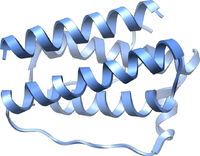
Photo from wikipedia
Leptin, discovered in 1994, is the prototype adipokine that fundamentally advanced our knowledge of the pathophysiology of adipose tissue, opening new avenues in the diagnosis and treatment of metabolic diseases.… Click to show full abstract
Leptin, discovered in 1994, is the prototype adipokine that fundamentally advanced our knowledge of the pathophysiology of adipose tissue, opening new avenues in the diagnosis and treatment of metabolic diseases. Until then, the function of adipose tissue was considered to be largely that of an inert, depot storage organ, i.e. acting mainly as an organ storing energy in the form of triglycerides and possibly contributing in part to insulating the body from cold. Following the discovery of leptin, numerous adipokines have been discovered, thereby rendering the adipose tissue the largest and most active endocrine organ. Leptin is mainly secreted by the white adipocytes. Its circulating levels are associated with total fat mass in adults: the higher the fat mass, the higher the leptin levels. It seems that subcutaneous fat produces more leptin than the visceral adipose tissue, which may, at least partly, explain the higher leptin levels observed in women than men. The production of leptin from brown adipose tissue remains controversial and leptin expression in brown adipose tissue may derive from white adipocytes that reside within brown adipose tissue. Leptin levels are also influenced, secondarily, by other factors. For example, leptin levels decrease while on a hypocaloric diet, therefore, under normal circumstances, they not only reflect long-term energy availability by reflecting total energy stored as fat, but they reflect short-term energy availability. By binding to and activating leptin receptors, leptin has multiple central and peripheral actions. By acting centrally, primarily in the arcuate nucleus of the hypothalamus, on the basis of experiments in rodents, leptin decreases appetite. Through its complex actions and interactions, leptin is considered to play a key role in the pathogenesis of obesity and related comorbidities, including type 2 diabetes mellitus (T2DM), nonalcoholic fatty liver disease (NAFLD) and cardiovascular diseases, but also has a distinct role in regulating other systems, such as the neuroendocrine, musculoskeletal, gastrointestinal, reproductive and immune systems.
Journal Title: Current Medical Research and Opinion
Year Published: 2022
Link to full text (if available)
Share on Social Media: Sign Up to like & get
recommendations!